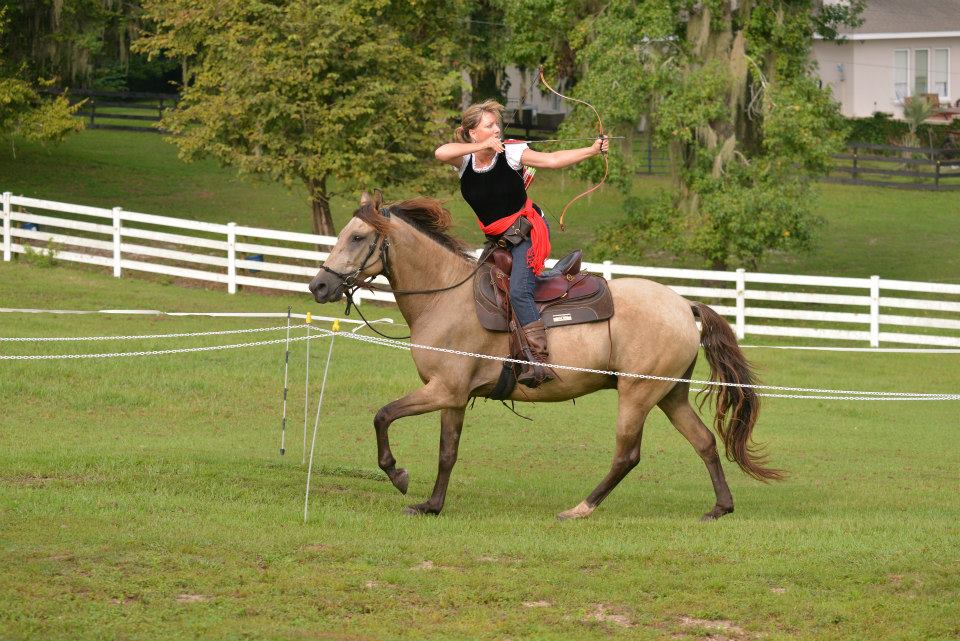In Brazil, Mangalarga Marchadors must pass strict inspections with standards for conformation, gait, temperament, performance and endurance. Points must be earned in each category for the horse to attain permanent registration and be allowed to breed.
Our breeding program endorses that rigor in selecting horses eligible to breed and bear the international mark of quality – the horseshoe M brand of the ABCCMM. All of our foundation breeding stock are dual registered, and have been inspected and approved for breeding by the ABCCMM, either in Brazil, or here in the U.S..
ATTRIBUTES
The Mangalarga Marchador averages between 14.2 and 16 hands in height and weighs between 850 and 1100 lbs. Although grays are common, chestnut, black, bay, buckskin, palomino and paint horses are also present. An adept and extremely versatile breed, the Mangalarga Marchador is fast becoming one of the most sought after breeds. As with many Iberian breeds they are good cattle horses. They are known for setting the Guinness Book of World Records endurance ride of 8,694 miles in 1994. A perfect trail horse, they could also excel in other disciplines that require agility, stamina, speed and a sound mind.
Training of this breed is facilitated by its intelligence, and uses for the breed are unlimited. In work with cattle, in sports, in Brazilian functional trials, or in cross-country horsemanship, the Marchador is outstanding and is obtaining excellent results in comparison to other breeds. This breed is extremely docile and is commonly mounted by children. Here in North America, the Marchador competes and shows in both western (mounted shooting, team penning), english (dressage, jumping), endurance riding and also pure pleasure.
HISTORY
The most popular and widespread horse in Brazil is the Mangalarga Marchador, which developed in 1740. Joao Francisco of Portugal settled in Brazil at the hacienda Campo Alegre, where the Marchador horses began to emerge. Francisco adopted the surname Junqueira to designate his native city. One of his twelve children, Gabriel Francisco Junqueira, the Baron of Alfenas, is credited with the expansion and development of the breed. His friend, Dom Pedro I (1798−1834), Emperor of Brazil and son of Joao IV of Portugal, gave him an Alter Real stallion named Sublime.
The stallion Sublime was the descendant of two horses brought from the breeding farm Coudelaria Alter do Chao in Portugal by Dom Joao VI during the invasion of the Iberian Peninsula by Napoleonic troops. In Brazil, Sublime was crossed with mares of the hacienda Campo Alegre: Spanish Jennets, Criollos and Andalusians. Most of the Spanish horses used at the hacienda in launching the breed were the famous Spanish Jennet, known to be a fast, smooth ambler. The offspring of Sublime produced horses with the characteristics of the present-day Mangalarga Marchador horse: docility and smooth gaits, with a cadenced rhythmic gait called the marcha.
© 1995 University of Oklahoma Press, Bonnie L. Hendricks, International Encyclopedia of Horse Breeds, Reprinted by permission of the publisher
GAIT
The reason for so much preoccupation with the marcha, indicated by the name of the breed is that this gait in unique in the world. The famous Spanish Jennets have died out, and the Marchador is probably the purest surviving remnant of that breed. No other breeds have been crossed into the Mangalarga Marchador. Due to the triple support exhibited in the Mangalarga Marchador, the marcha gives a very comfortable ride with little friction. The Mangalarga Marchador neither trots nor paces, naturally going from the smooth marching gait into a wonderful canter.
© 1995 University of Oklahoma Press, Bonnie L. Hendricks, International Encyclopedia of Horse Breeds, Reprinted by permission of the publisher
NAMING CONVENTION/BLOODLINES
In keeping with their long heritage, the names of the Marchadors tell a story reflecting their roots. Mangalarga Marchadors always have compound names. The horse’s full name and bloodline names tell you the origin of your horse and his heritage.
One of the names is like a first name to the horse, but the other name is like a surname so the combination is unique in the breed. The “surname” is the breeding farm. So if your farm name was Darley LTD, the farm designates its offspring in one of the following ways:
Xxxx do Darley (da Darley, de Darley), Xxxx DL, DL Xxxxx (initials), Darley xxxx (farm name first), Xxxx Darley (farm name last)
Originally, there were only a few founding farms in Brazil. These farm names resonate in the pedigree of every Mangalarga Marchador. Some are still in existence today. Historic farm names like Abaiba, Angahay, Bela Cruz, Caxambu, Favacho, Herdade, J.B., Passa Tempo, Tabatinga and Traituba represent some of the bloodlines here in North America.





